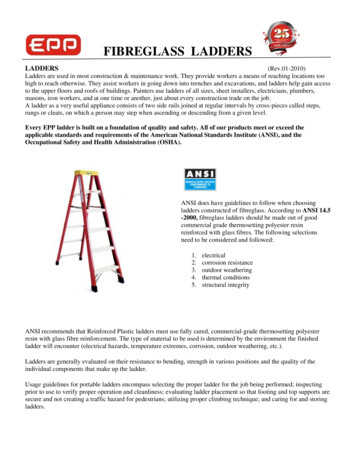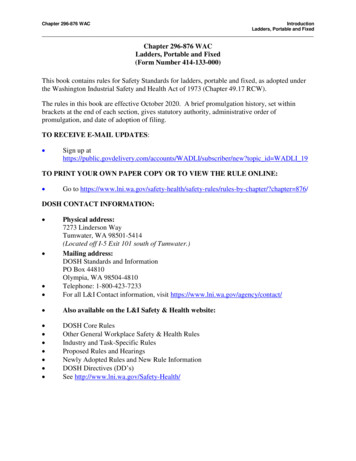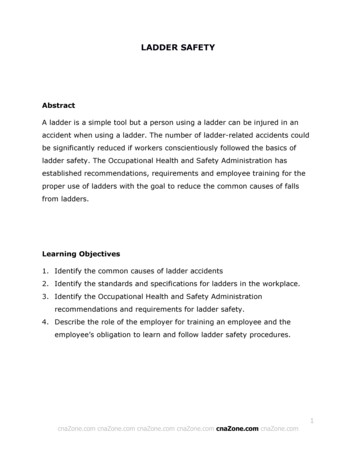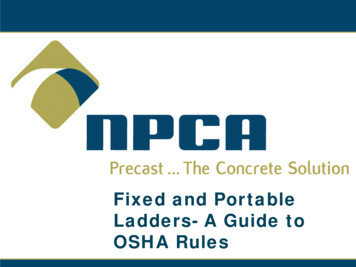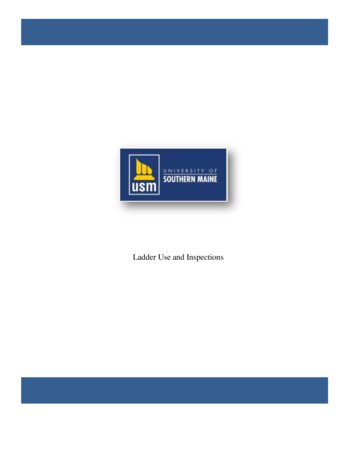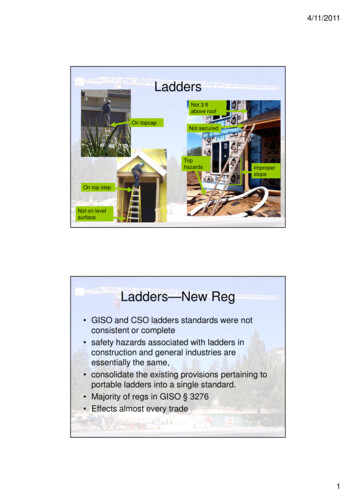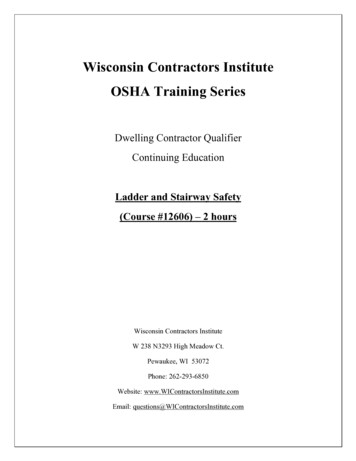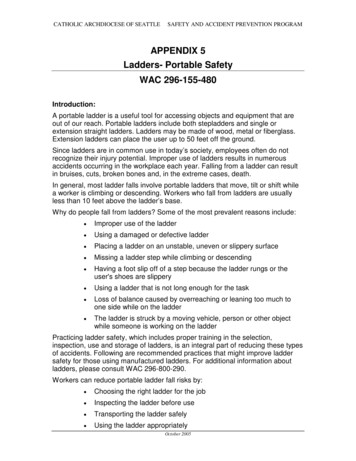
Transcription
CATHOLIC ARCHDIOCESE OF SEATTLESAFETY AND ACCIDENT PREVENTION PROGRAMAPPENDIX 5Ladders- Portable SafetyWAC 296-155-480Introduction:A portable ladder is a useful tool for accessing objects and equipment that areout of our reach. Portable ladders include both stepladders and single orextension straight ladders. Ladders may be made of wood, metal or fiberglass.Extension ladders can place the user up to 50 feet off the ground.Since ladders are in common use in today’s society, employees often do notrecognize their injury potential. Improper use of ladders results in numerousaccidents occurring in the workplace each year. Falling from a ladder can resultin bruises, cuts, broken bones and, in the extreme cases, death.In general, most ladder falls involve portable ladders that move, tilt or shift whilea worker is climbing or descending. Workers who fall from ladders are usuallyless than 10 feet above the ladder’s base.Why do people fall from ladders? Some of the most prevalent reasons include: Improper use of the ladder Using a damaged or defective ladder Placing a ladder on an unstable, uneven or slippery surface Missing a ladder step while climbing or descending Having a foot slip off of a step because the ladder rungs or theuser's shoes are slippery Using a ladder that is not long enough for the task Loss of balance caused by overreaching or leaning too much toone side while on the ladder The ladder is struck by a moving vehicle, person or other objectwhile someone is working on the ladderPracticing ladder safety, which includes proper training in the selection,inspection, use and storage of ladders, is an integral part of reducing these typesof accidents. Following are recommended practices that might improve laddersafety for those using manufactured ladders. For additional information aboutladders, please consult WAC 296-800-290.Workers can reduce portable ladder fall risks by: Choosing the right ladder for the job Inspecting the ladder before use Transporting the ladder safely Using the ladder appropriatelyOctober 2005
Portable Ladder Safety Storing the ladder properlyReducing Portable Ladder Risks from Falls and/or Failure:1. Choosing the Right LadderLadders are easier and safer to use when you match them with theappropriate task. Be sure to use a ladder of proper length that will reachbeyond the working height that is needed. If working on a roof, the laddermust extend three feet above the roofline. If using an extension ladder,make sure that the sections overlap enough to prevent buckling.Select a ladder that has a working load that exceeds the combined weightof the climber and the load being carried. The rating can be found on alabel located on the side of the ladder. (See "Duty Ratings)Make sure that ladder steps and rungs have a skid resistant surface that willhelp minimize the risk of slipping. (“Skid resistant” means corrugated,knurled, dimpled or coated with skid-resistant material.)Avoid using any ladder with conductive (metal) side rails near exposed,energized equipment; such ladders must be permanently, legibly markedwith the words, “WARNING – Do Not Use Around Energized ElectricalEquipment”.2. ANSI Duty RatingsA ladder's duty rating tells you the maximum weight capacity of the ladder.The American National Standards Institute (ANSI) determines the standardfor the categories of duty ratings. A ladder must be rated to carry thecombined weight of the climber and the load being carried. Type IAA Industrial Special Duty UseDuty rating375 pounds. Type IAIndustrial Extra Heavy UseDuty rating300 pounds. Type IIndustrial Heavy UseDuty rating250 pounds. Type IICommercial Medium UseDuty rating200 pounds. Type IIIHousehold Light UseDuty rating200 pounds.Note: Type III ladders are NOT approved for use in workplaces regulatedby WISHA. Only Type I and Type II ladders are allowed on parishproperty.Ladders are readily available that are not rated. Never purchase or use anyladder that is not a rated ladder.WISHA requires that all ladders in the work place must bear ANSI andOSHA labels.3. Inspecting the Ladder before Each UseCheck the condition of the ladder before each use. Make sure the ladder isin good condition before climbing on it. Avoid working on ladders that arecovered with ice, snow, mud or other slippery materials. Rungs should beclean and dry.Page 2
Portable Ladder SafetyInspect ladders to find defects, such as: loose or broken steps or rungs damaged base, shoe or foot of the ladder loose joints or bolts cracks, rot or splinters hardware fittings in poor condition; sharp edges, rough burrs, faultywelds hooks and locks in poor condition ropes or cables in poor conditionA ladder that is broken, damaged or bent should not be used - discard it. Donot make temporary repairs to a ladder that has broken or missing partsunless you are qualified to do so. Inspect any ladder that has collapsed ortipped over for structural defects.Ladders should not be painted because paint can conceal defects thataffect the integrity of the ladder. Use a transparent preservative to protectthe surface of wooden ladders.4. Transporting the Ladder SafelyWhenever moving a ladder, carry the ladder correctly. Ladders should becarried parallel to the ground. Step-ladders should be carried in the closedposition. Be sure to hold the side rail in the middle of the ladder so the loadcan be balanced. Always use two or more persons when moving a long(more than 20 feet) ladder.Properly support a ladder when transporting it on or in a vehicle, and makesure to tie it down securely.5. Using the Ladder Appropriatelya. Always read the use instructions affixed to the ladder before using theladder.b. Place the ladder with your safety in mind. Put the ladder near the workyou are performing. Before using a ladder outside, make sure it will nothit electrical wires, tree limbs or any other obstructions when it is beingset up or in place. Avoid placing a ladder in front of a door that could beopened into the ladder. If working in high traffic areas, protect the baseof the ladder so that it will not be struck by passing vehicles orpedestrians.c. Place a straight or extension ladder using a 4:1 ratio: for every four feetof height of the ladder, move the base of the ladder one foot away fromthe wall. Tie off extension ladders securely to ensure stability. If youintend to climb onto a roof or platform from a ladder, be sure the ladderextends at least three feet above the edge of the roof or platform.Page 3
Portable Ladder Safetyd. Ensure that the ladder is stable for use by placing the feet of the ladderon firm, even ground. All four points of a ladder must be secure - placedto prevent slipping, or tied in place, or braced. When working from aladder over 25 feet from the ground or floor, secure the ladder at boththe top and the bottom.e. When using a stepladder, make sure it is fully open with the bracesbetween the two sections fully extended and locked. Never stand on thetop rung of any ladder.f. Climb the ladder carefully - most falls occur when a worker is ascendingand descending the ladder. Be sure to place both feet firmly on theladder rungs and steps. Grasp the side rails with both hands so you willbe able to avoid a fall if a rung fails or your foot slips. A good rule ofthumb is to maintain three points of contact with the ladder at all times two feet and one hand or two hands and one foot. Always face theladder when climbing up and down.g. Do not lean over the side of the ladder or reach beyond your arm'snormal extension while working on the ladder. Remember the "BeltBuckle Rule": Keep your belt buckle positioned between the side rails atall times, which will maintain your center of gravity on the ladder. Do notallow more than one worker on the ladder at a time. Never attempt to“jog” or “walk” the ladder to a new location while standing on it - climbdown to the ground and reposition the ladder.h. Wear appropriate clothing when using ladders. Wear rubber soled (nonslip) shoes that are clean and dry. Make sure that your shoelaces aretied securely and be sure that your pant legs aren't so long that theyextend under your shoes and cause you to slip.i.If you need to use toolboxes or materials, raise and lower those types ofheavy, awkward loads with a hand line or hoist. Attach light, compacttools or materials to the ladder or to yourself using a tool belt. Protectthe area underneath your ladder to reduce the chance of an objectaccidentally being dropped on someone below.Storing the Ladder Properly1. Take proper care of your ladder. Proper storage of the ladder will helpreduce damage to the ladder. Straight ladders are best stored in racks or onwall brackets, and should be supported to prevent sagging and warping.Stepladders should be stored in the upright, closed position. As moistureand sun exposure are the two main enemies of wood ladders, these shouldbe protected from moisture, insect damage and excessive heat.2. Using ladders safely will help protect you from the risk of falling when youwork off the ground. The injury you prevent by taking the time to use theladder correctly may be your own.Page 4
Portable Ladder SafetyNIOSH Portable Wooden Ladders .18.19.Are all wooden ladder parts (a) sound, (b) free of sharp edges andsplinters, and (c) on visual inspection, free from shake, wane,compression failure, decay, or other irregularities?Are all portable wooden step ladders 20 feet or less in length?Is the portable step ladder of uniform step spacing and less than 12inches apart?Is the inside width between side rails of each portable step ladder at least11-1/2 inches?Is the metal spreader or locking device of portable step ladders ofsufficient size and strength to securely hold the front and back sections inthe open position?Are all single wooden ladders 30 feet or less in length?Are all two-section wooden extension ladders 60 feet or less in length?Are all wooden ladders in good condition with the joint between the stepand side rails tight? Are all hardware and fittings securely attached? Arethe movable parts operating freely without binding or undue play?Are the metal bearings of locks, wheels, pulleys, etc. frequentlylubricated?Is frayed or badly worn rope replaced?Are the safety feet or other auxiliary equipment kept in good condition?Are wooden ladders inspected frequently? Are those with defectswithdrawn from service for repair or destruction and tagged or marked as“Dangerous, Do Not Use?”Note: Wooden ladders with missing steps, rungs, or cleats;broken side rails; or other faulty equipment must not be used.Discarded ladders should be cut down the center of the rungs.Are rungs kept free of grease and oil?Are wooden ladders used and placed so that the horizontal distance fromthe top support to the foot of the ladder is one quarter of the workinglength of the ladder (the length along the ladder between the foot and thetop support)?Is the ladder (a) placed to prevent slipping, (b) lashed, or (c) held inposition?Is the use of wooden ladders in the horizontal position prohibited?Note: Ladders must never be used as platforms, runways, orscaffolds.Is only one person allowed on the ladder at one time?Are ladders placed away from the front of doors that open toward theladder unless the door is blocked, locked, or guarded?Are ladders always placed on stable bases?Page 5
Portable Ladder Safety20.21.22.23.24.25.26.Note: Ladders must never be placed on boxes, barrels, or other unstablebases.Is the splicing of short ladders together prohibited?Is the use of the tops of stepladders as steps prohibited?When in use, do all 36-foot or less two-section extension wooden laddershave a minimum overlap of 3 feet between the two sections?When in use, do all 36- to 48-foot two-section extension wooden laddershave a minimum overlap of 4 feet between the two sections?When in use, do all 48- to 60-foot two-section extension wooden laddershave a minimum overlap of 5 feet between the two sections?If ladders are used to gain access to a roof, are they extended at least 3feet above the point of support?Are all portable rung ladders equipped with non-slip bases where a hazardof slipping exists?Note: Non-slip bases are not intended as a substitute for care in safelyplacing, lashing, or holding a ladder that is being used.Portable Metal Ladders27.28.29.30.31.32.33.34.35.36.Are metal ladders maintained in good usable condition at all times?Are the rungs and steps of portable metal ladders corrugated, knurled,dimpled, coated with skid-resistant material, or otherwise treated tominimize the possibility of slipping?Are all portable metal single ladders 30 feet or less in length?Are all portable metal two-section ladders 48 feet or less in length?If a portable metal ladder tips over, is it inspected immediately fordamage?Note: The inspection must include looking for dents, bends, orexcessively dented rungs; and checking all rungs to side rail connections,checking hardware connections, and checking rivets for shears.If metal ladders are exposed to oil and grease, are they cleanedimmediately?Are metal ladders with defects marked and taken out of service untilrepaired by either the maintenance department or the manufacturer?Are metal ladders placed at the proper angle?Note: That is, the base distance from the vertical wall to the ladder is onefourth the working length of the ladder or height at which the laddertouches the wall.Is the use of a metal ladder as a brace, skid, guy or gin pole, gangway, orfor other uses than that which the ladder was intended prohibited?Has inspection been conducted to determine if metal ladders mightcontact energized conductors?Note: The use of metal ladders should be prohibited wherever they mightmake contact with energized electrical conductors.Page 6
Portable Ladder SafetyNIOSH Construction Ladder Safety e ladders or stairways provided at all points of access that are elevated19 inches or more, and no ramp, runway, sloped embankment, orpersonnel hoist is provided?Does a competent person provide ladder training that teaches users howto recognize hazards and procedures for minimizing these hazards?Is ladder retraining provided when necessary?Can ladders support the load they are expected to carry?Are ladder rungs, cleats, and steps parallel, level, and uniformly spacedwhen the ladder is in position for use?Are rungs, cleats, and steps of portable ladders (other than step stoolsand extension trestle ladders) spaced at least 10 but not more than 14inches apart (as measured between center lines of the rungs, cleats, andsteps)?Are rungs, cleats, and steps of step stools at least 8 but not more than 12inches apart (as measured between center lines of the rungs, cleats, andsteps)?Are rungs, cleats, and steps of the base section of extension trestleladders at least 8 but not more than 18 inches apart (as measuredbetween center lines of the rungs, cleats, and steps)?Are rungs, cleats, and steps of the extension section of extension trestleladders at least 6 but not more than 12 inches apart (as measuredbetween center lines of the rungs, cleats, and steps)?Is the clear distance between side rails for all portable ladders at least 111/2 inches?Are the rungs and steps of portable metal ladders corrugated, knurled,dimpled, coated with skid-resistant material, or otherwise treated tominimize slipping?Are ladders prohibited from being tied or fastened together to providelonger sections (unless they are designed for such use)?Is a metal spreader or locking device provided on each stepladder to holdthe front and back sections in an open position when the ladder is beingused?Are ladders surfaced to prevent injury from punctures or lacerations, andto prevent snagging of clothing?Is it prohibited to coat wood ladders with any opaque covering, except foridentification or warning labels that are placed on only one face of a siderail?Do portable ladders extend at least 3 feet above the upper landingsurface for which the ladder is used to gain access?Note: As an alternative, secure the ladder at its top to a rigid support thatwill not deflect. Use a grasping device (such as a grab rail) to mount anddismount the ladder. The extension should never be such that the ladderPage 7
Portable Ladder .32.33.34.deflection under load would, by itself, cause the ladder to slip off itssupport.Are ladders maintained free of oil, grease, and other slipping hazards?Are ladders loaded at or below the maximum intended load for which theywere built, or at or below the manufacturer's rated?Are ladders only used for the purpose for which they were designed?Are non-self-supporting ladders used at an angle such that the horizontaldistance from the top support to the foot of the ladder is approximately 1/4of the working length of the ladder (the distance along the ladder betweenthe foot and the top support)?Are ladders used only on stable and level surfaces, unless secured toprevent displacement?Are ladders used on slippery surfaces ONLY when they are secured orprovided with slip-resistant feet to prevent displacement?Note: Do not use slip-resistant feet as a substitute for care in placing,lashing, or holding a ladder on surfaces such as flat metal or concrete thatcannot be prevented from becoming slippery.Are ladders secured to prevent displacement, especially in busy, hightraffic areas?Note: As an alternative, a barricade may be used to keep the activities ortraffic away from the ladder.Is the area around the top and bottom of ladders kept clear?Is the top of a non-self-supporting ladder placed with the two railssupported equally, unless it has a single support attachment?Is it prohibited to move, shift, or extend ladders while they are occupied?Do ladders have nonconductive side rails if they are used where theycould contact exposed energized electrical equipment?Is standing on the top or top step of a stepladder prohibited?Is climbing on the cross-bracing on the rear section of stepladdersprohibited?Note: This is allowed IF the ladder is designed and provided with steps forclimbing on both front and rear sections.Are ladders inspected periodically by a competent person and after anyincident that could affect their safe use?Are portable ladders with structural defects (a) immediately marked in amanner that readily identifies them as defective, (b) tagged with DO NOTUSE or similar language, or (c) withdrawn from service until repaired?Note: Structural defects include broken or missing rails, corrodedcomponents, or other faulty or defective components.Does a ladder that is repaired meet its original design criteria, before it isreturned to use?Do all students and employees face the ladder when moving up or downthe ladder?Do all students and employees use at least one hand to grasp the ladderwhen moving up or down the ladder?Page 8
Portable Ladder Safety35.Is it prohibited to carry any object or load that could cause a person tolose balance and fall?DefinitionsCleat: a ladder crosspiece of rectangular cross section placed on edge. Aperson steps on a cleat while ascending or descending a ladder.Extension trestle ladder: a self-supporting portable ladder, adjustable in length,consisting of a trestle ladder base and a vertically adjustable extension section,with a suitable means for locking the ladders together.Portable ladder: a ladder that can be readily moved or carried.Step stool (ladder type): a self-supporting, foldable, portable ladder,nonadjustable in length, 32 inches or less in overall size, with flat steps andwithout a pail shelf, designed to be climbed on the ladder top cap as well as allsteps. The side rails may continue above the top cap.Page 9
Ladders- Portable Safety October 2005 WAC 296-155-480 . Introduction: A portable ladder is a useful tool for accessing objects and equipment that are out of our reach. Portable ladders include both stepladders and single or . OSHA labels. 3. Inspecting the Ladder before Each Use . Check the condition of the ladder before each use. Make sure .
